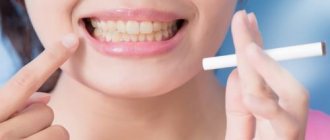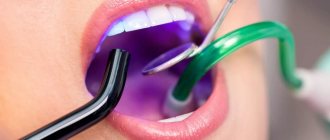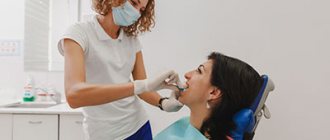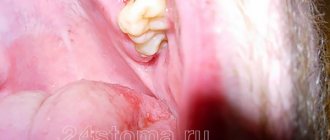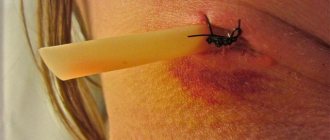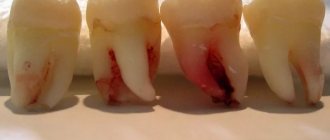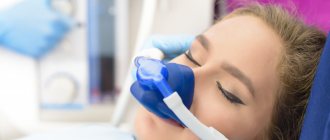The procedure of removing a tooth or tooth root is a common operation in dental surgery. It must be performed by a dentist-surgeon. During tooth extraction, tissue and blood vessels are damaged, leaving a wound filled with thickening blood.
To ensure healing proceeds quickly and there are no complications, you should follow simple recommendations after tooth extraction:
- remove the gauze pad no earlier than 20 minutes after the procedure;
- do not eat for 2 hours;
- Do not eat hot food during the next day;
- do not rinse your mouth;
- do not eat food that is harmful to the oral cavity;
- do not examine the wound using improvised means;
- do not apply compresses;
- Do not overcool, do not overheat, and do not undergo physical exertion for several days.
When following the recommendations, a lot of questions still arise. Let's look at the most common ones.
Light seal: is it possible to smoke?
When can you eat after a light filling
? Can you smoke after a light filling?
Consequences of smoking after having a filling installed
Is it possible to smoke after a temporary filling?
Despite the fact that modern filling materials have excellent characteristics, the durability of the filling depends on the actions of the person himself. Of course, the doctor gives certain recommendations on what can and cannot be done immediately after dental treatment, but not everyone follows them. What consequences can this lead to and is it possible to smoke after a light filling?
Botox injections: what are they?
The administration of Botox provokes a disruption of neuromuscular conduction, temporarily blocking the flow of nerve signals from muscles or glands. The use of this procedure allows you to relax the muscles, which helps smooth out facial wrinkles and creases on the face, reduce the work of the sweat glands, eliminating hyperhidrosis (excessive sweating).
The drug is administered subcutaneously or intramuscularly, after preliminary consultation with a doctor and a thorough examination of the injection area. The procedure takes from 5 to 20 minutes, there is practically no pain, and if necessary, superficial skin anesthesia is used. The recovery period is short, the result is noticeable after 2-7 days. But any impact on muscle fibers or nerve endings in the injection area can change the result and cause side effects, so it is important to follow a number of prohibitions and recommendations.
When can you eat after a light filling?
Today the most popular filling is light. Almost all dentists prefer it. On the first day after the procedure, the filling is extremely sensitive to any influences, since the material has not yet completely hardened. It is better to eat food after 1-2 hours, but it is undesirable to use foods and drinks containing dye, since the filling material easily absorbs coloring pigments.
What foods should be excluded on the first day after treatment:
- coffee, tea, red wine;
- beet;
- dark berries (blueberries, blueberries);
- various sauces.
Food should not be too hot or cold.
Anesthesia and anesthesia - 14 frequently asked questions
14 frequently asked questions about anesthesia and anesthesia General anesthesia - with this form of anesthesia, they sleep deeply, soundly and safely. Her response to pain is as repressed as her consciousness. Anesthetics are constantly supplied through the blood or breathing air. Therefore, this anesthesia is well controlled. Can be used in any surgery. (Masking anesthesia, laryngeal mask, anesthesia and intubation anesthesia) Regional anesthesia - covers a specific part of the body, depending on the plant. They remain conscious during the procedure or optionally choose twilight sleep, which includes spinal cord anesthesia (ankle and back anesthesia) and upper and lower limb locking. (Plexus anesthesia, knee block, etc.) Local anesthesia only makes a small part of your body insensitive to pain. This anesthesia procedure is performed by the surgeon himself.
What needs to be done before anesthesia?
Please tell your anesthesiologist about all the medications you are taking, including those you bought at the pharmacy! It is especially important to be sober, not to eat 6 hours before surgery and not to drink liquids 2 hours before surgery! (Exception: a few sips of water for taking important medications - but you should definitely check this with your anesthesiologist!)
On the day of anesthesia, refrain from smoking!
Remove makeup and nail polish!
Jewelry - including piercings - must be removed! In addition, glasses, contact lenses and hearing aids, as well as removable parts of teeth, as well as other prosthetics. Exceptions are possible only after consultation with an anesthesiologist.
Why can't you eat and drink before surgery? Anesthesia eliminates protective reflexes (such as automatic swallowing). As a result, there is a risk of stomach contents entering the pharynx and then into the respiratory tract. This can lead to severe pneumonia. The risk of swallowing (aspiration) increases the shorter the last meal. Therefore, it is in your best interest to tell the anesthesiologist exactly when you last ate and drank.
Why can't I smoke on the day of surgery? Smoking may increase stomach acid secretion and therefore has the same risk as eating before surgery. Stomach juice can drain back into the esophagus and into the lungs (aspiration), causing pneumonia there.
What are the risks and complications of general anesthesia?
- Nausea after surgery (usually caused by drugs). It only occurs in patients with a certain predisposition and can be treated very well with medication.
- Hoarseness (after intubation) usually resolves within 24 hours.
- Aspiration (which means foreign bodies entering the trachea or lungs when swallowed). If the patient adheres to the prescribed preoperative behavioral rules (“sober”!), aspiration is practically impossible. This hazard is most common in acute procedures (unplanned surgeries).
- Cardiovascular disorders (dangerous in pre-existing cardiovascular diseases) can be caused by the stress of surgery.
- Cooling (today very rare: during surgery the patient is warmed up accordingly) is manifested by postoperative tremor.
- Damage to teeth can occur during intubation - but is very rare.
- Malignant hyperthermia (extremely rare, 1:250,000, but life-threatening) is caused by the patient's genetic predisposition. This complication begins with a significant increase in body temperature and can lead to kidney failure. If there is a known history of malignant hyperthermia in the family, be sure to tell your anesthesiologist!
How quickly does anesthesia work? Whether the anesthesia begins through the bloodstream or the breathing air, you will fall asleep within seconds.
Is it possible to wake up during surgery or hear something? After you fall asleep, your anesthesiologist constantly checks the depth of anesthesia in addition to vital organ functions. With the medications available today, especially gaseous anesthetics, you can almost completely eliminate the possibility of waking up or listening during surgery. In addition, modern devices make it possible to measure the depth of anesthesia.
Will there be any pain after the operation? About 25% of patients complain of nausea after surgery. Reasons include personal predisposition (eg, motion sickness), type of surgery, and ultimately the anesthesia procedure chosen. You can counteract nausea with preventive medications. Although nausea cannot be completely avoided, it is less frequent and milder.
When can I eat and drink again? Depending on the type of operation, this time interval can vary greatly. It is best to wait at least 3 hours to drink and feed solid food for at least 6 hours.
Will there be pain when waking up after anesthesia? No. Although pain cannot be completely avoided after surgery, you will, of course, be given appropriate pain therapy both during the recovery phase and afterwards. The need for painkillers mainly depends on the operation being performed.
When can you go home after general anesthesia for an outpatient procedure? Discharge should always be carried out by the surgeon and anesthesiologist no earlier than 2 hours after the operation. The patient is again warned about the need to drive a vehicle during the first 24 postoperative hours, enter into any contracts, or take alcohol or sedatives (except for prescribed medications).
What is regional anesthesia? Regional anesthesia is the temporary loss of sensation of pain in a specific area of the body due to interruption of pain transmission to the brain. Typically the patient remains conscious during this form of anesthesia.
What types of regional anesthesia are there? Interruption of anesthesia is possible in several places: In the area of the spinal cord (“cross stitch”) In the area of the nerve plexus (plexus), that is, where the nerve fibers merge with the nerves after leaving the spinal cord (plexus of anesthesia) In the area of individual nerves (so called peripheral regional anesthesia or peripheral nerve blocks)
Spinal and epidural anesthesia. Both are regional spinal cord anesthesia procedures. The difference between the two methods is the depth of penetration. Unlike spinal anesthesia, with epidural anesthesia, the height of the puncture site and the amount of local anesthesia determine the location and size of the anesthesia area. "Regional anesthesia" occurs because only a specific part of the body, the "spinal cord," is anesthetized because the nerves coming out of the spinal cord are anesthetized. Unlike general anesthesia, the patient is conscious during the operation.
Spinal anesthesia can be used for all operations below the navel, that is, for operations on the legs, pelvis, perineum and lower abdomen. With epidural anesthesia, operations can be performed on the upper abdomen, pelvic and genital areas, and on the legs. Spinal anesthesia is a safe procedure using modern, state-of-the-art equipment. As with any method, complications are sometimes possible, but they are usually temporary. Permanent damage is extremely rare.
Are you awake during surgery under local anesthesia? Depending on the patient's wishes, this may be awake. But if he prefers to sleep, he can be given a mild tranquilizer.
Does the patient have to be sober before local anesthesia? As with general anesthesia, the same rules of conduct apply to regional anesthetics.
Sources:
- Anesthesiology. National leadership (ed. A.A. Bunyatyan, V.M. Mizikov). M., ed. Group "Geotar-Media". 2011.
- Levshankov A.I. Ensuring patient safety (monitoring) during anesthesia, resuscitation and intensive care. Guide to anesthesiology and resuscitation (ed. Yu.S. Polushin). St. Petersburg - 2004. – pp. 137-139
- Likhvantsev V.V., Ulitkina O.N., Rezepov N.A. Postoperative delirium: what new does the new ESA-2017 guideline offer us? // Bulletin of Anesthesiology and Reanimatology. - 2017; 14(2): 41-47)
- General anesthesia. In the book: Anesthesiology and resuscitation. Textbook for training highly qualified personnel, vol. 1 (S.A. Sumin, K.G. Shapovalov). Moscow: Medical Information Agency, 2021. P. 257-286;
- Terminology and classification of anesthesia methods. In the book: Guide to anesthesiology and resuscitation (ed. Yu.S. Polushin). St. Petersburg, 2004. Pp. 279-282
- Continuum of depth of sedation: Definition of general anesthesia and levels of sedation/analgesia. Committee of Origin: Quality Management and Departmental Administration (Approved by the ASA House of Delegates on October 13, 1999, and last amended on October 15, 2014)
Is it possible to smoke after a light filling?
Many owners of a bad habit immediately light a cigarette upon leaving the dentist. What consequences can this lead to? During treatment, for example, caries or periodontitis, the structure of the teeth is disrupted, and sometimes the mucous membrane can be injured. Tobacco smoke negatively affects the healing and enamel of teeth. In addition, nicotine, reacting with filling materials, negatively affects their properties. Therefore, after treatment, it is better to give up cigarettes for at least a couple of hours, or better yet, for a day. This will help the tissues recover faster and the filling to become stronger.
Possible complications if recommendations are not followed
Recommendations and restrictions are related to the fact that certain exposures can provoke unpleasant consequences and complications. Thus, some medications and alcohol threaten the appearance of swelling or bruising on the face after injections.
Temperature effects can reduce the effect of the procedure or lead to undesirable effects (ptosis of the eyelids, impaired facial expression in individual muscles).
Massage or cosmetic procedures in the facial area can speed up the removal of the drug from the tissues, which reduces the effect of the procedure.
Following all doctor's recommendations helps eliminate the risk of unwanted effects and prolong the effect of Botox.
Our clinic address: St. Petersburg, st. Chernyakhovsky, 53 m. Ligovsky Prospekt

